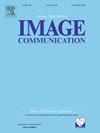OTPL: A novel measurement method of structural parallelism based on orientation transformation and geometric constraints
IF 3.4
3区 工程技术
Q2 ENGINEERING, ELECTRICAL & ELECTRONIC
引用次数: 0
Abstract
Detecting parallel geometric structures from images is a significant step for computer vision tasks. In this paper, an algorithm called Orientation Transformation-based Parallelism Measurement (OTPL) is proposed in this paper to measure the parallelism of structures including both line structures and curve structures. The task is decomposed into measurements of parallel straight line and parallel curve structures due to the inherent geometric differences between them, where the parallelism between curve structures can be further transformed into a matching problem. For parallel straight lines, the angle constraints and the rate of overlapping projection are considered as the parallel relationship selection rules for the candidate lines. For the parallel curves, the approximate vertical growing (AVG) algorithm is proposed to accelerate the search of adjacent curves and each smooth curve is coded as a vector with different angle values. The matching pairs are extracted through cosine similarity transformation and convexity consistency. Finally, the parallel curves are extracted by a decision-making process. The proposed algorithm is evaluated in a comprehensive manner, encompassing both qualitative and quantitative approaches, with the objective of achieving a more robust assessment. The results demonstrate the algorithm's efficacy in identifying parallel structures in both synthetic and natural images.
OTPL:一种基于方位变换和几何约束的结构平行度测量方法
从图像中检测平行几何结构是计算机视觉任务的重要步骤。本文提出了一种基于方向变换的平行度测量算法(OTPL),用于测量直线结构和曲线结构的平行度。由于平行直线结构与平行曲线结构之间存在固有的几何差异,该任务被分解为平行直线结构与平行曲线结构的测量,其中曲线结构之间的平行度可以进一步转化为匹配问题。对于平行直线,考虑角度约束和重叠投影率作为候选直线的平行关系选择规则。对于平行曲线,提出了近似垂直生长(AVG)算法来加速相邻曲线的搜索,并将每条光滑曲线编码为具有不同角度值的矢量。通过余弦相似变换和凸一致性提取匹配对。最后,通过决策过程提取平行曲线。提出的算法以全面的方式进行评估,包括定性和定量方法,目的是实现更稳健的评估。结果表明,该算法在人工图像和自然图像中都能有效地识别出平行结构。
本文章由计算机程序翻译,如有差异,请以英文原文为准。
求助全文
约1分钟内获得全文
求助全文
来源期刊

Signal Processing-Image Communication
工程技术-工程:电子与电气
CiteScore
8.40
自引率
2.90%
发文量
138
审稿时长
5.2 months
期刊介绍:
Signal Processing: Image Communication is an international journal for the development of the theory and practice of image communication. Its primary objectives are the following:
To present a forum for the advancement of theory and practice of image communication.
To stimulate cross-fertilization between areas similar in nature which have traditionally been separated, for example, various aspects of visual communications and information systems.
To contribute to a rapid information exchange between the industrial and academic environments.
The editorial policy and the technical content of the journal are the responsibility of the Editor-in-Chief, the Area Editors and the Advisory Editors. The Journal is self-supporting from subscription income and contains a minimum amount of advertisements. Advertisements are subject to the prior approval of the Editor-in-Chief. The journal welcomes contributions from every country in the world.
Signal Processing: Image Communication publishes articles relating to aspects of the design, implementation and use of image communication systems. The journal features original research work, tutorial and review articles, and accounts of practical developments.
Subjects of interest include image/video coding, 3D video representations and compression, 3D graphics and animation compression, HDTV and 3DTV systems, video adaptation, video over IP, peer-to-peer video networking, interactive visual communication, multi-user video conferencing, wireless video broadcasting and communication, visual surveillance, 2D and 3D image/video quality measures, pre/post processing, video restoration and super-resolution, multi-camera video analysis, motion analysis, content-based image/video indexing and retrieval, face and gesture processing, video synthesis, 2D and 3D image/video acquisition and display technologies, architectures for image/video processing and communication.
 求助内容:
求助内容: 应助结果提醒方式:
应助结果提醒方式:


